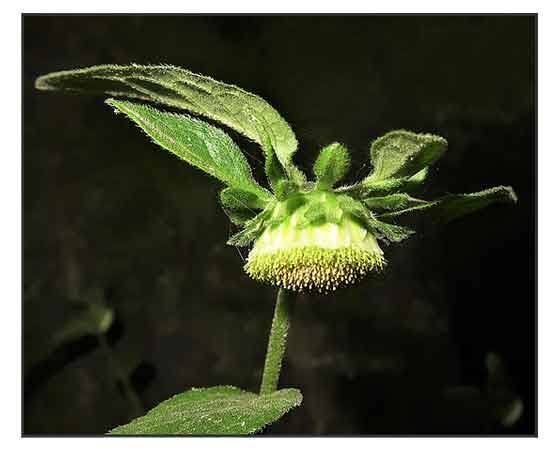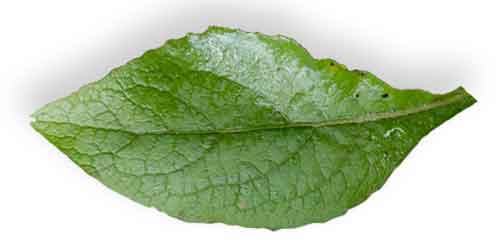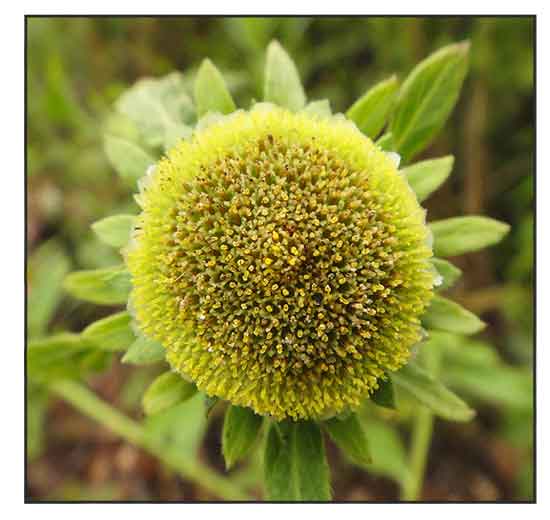 Gen info Gen info
- Carpesium is a genus of flowering plants in the aster family, Asteraceae. They are mainly perennial herbs, but some species are annuals. (3)
- Etymology: The genus name Carpesium derives from the species name Venegasia carpesioides due to the similarity between the flower heads of Venegasia and the buds of Carpesium. The specific epithet cernuum derives from Latin cernuus, meaning "lowered, nodded, with the face turned towards the earth". The specific name was defined by botanist Carl Linnaeus (1707-1778) in the publication "Species Plantarum" of 1753. (3)
Botany
•  Possibly annual herb, usually 30–60 cm high, with fine pale ± appressed hairs to ± cottony. Leaves with lamina elliptic to obovate, lower ones c. 10–18 cm long and 3–5.5 cm wide, upper ones usually 4–7 cm long and 1–2.5 cm wide; petiole to 2 cm long. Heads solitary, terminal on main and side branches, usually subtended by 1-several small leaves and nodding. Outer involucral bracts spreading or reflexed, lanceolate or elliptic, acute, entire, pubescent; inner bracts narrow-oblong, acute, obtuse or rounded, margins often slightly toothed, erect. Florets yellow. Achenes c. 4 mm long. (New South Wales Flora Online)
 • Nodding Carpesium is an annual herb, usually 1-2 ft tall, with fine pale hairs to somewhat cottony. Leaves are elliptic to obovate, lower ones about 10-18 cm long and 3-5.5 cm wide, upper ones usually 4-7 cm long and 1-2.5 cm wide. Leaf-stalks are up to 2 cm long. Flower-heads occur singly, at the ends of main and side branches, usually subtended by 1-several small leaves and looking down. Outer involucral bracts are spreading or reflexed, lance shaped or elliptic, pointed, entire, velvety. Inner bracts are narrow-oblong, acute, obtuse or rounded, margins often slightly toothed, erect. Florets are yellow. Seed-pods are about 4 mm long. (Flowers of India) • Nodding Carpesium is an annual herb, usually 1-2 ft tall, with fine pale hairs to somewhat cottony. Leaves are elliptic to obovate, lower ones about 10-18 cm long and 3-5.5 cm wide, upper ones usually 4-7 cm long and 1-2.5 cm wide. Leaf-stalks are up to 2 cm long. Flower-heads occur singly, at the ends of main and side branches, usually subtended by 1-several small leaves and looking down. Outer involucral bracts are spreading or reflexed, lance shaped or elliptic, pointed, entire, velvety. Inner bracts are narrow-oblong, acute, obtuse or rounded, margins often slightly toothed, erect. Florets are yellow. Seed-pods are about 4 mm long. (Flowers of India)
Distribution
- Native to the
Philippines.
- In Luzon: Benguet, Ifugao, Mountain Province, Nueva Viscaya.
In open sites and light forest in the montane zone, 1800-2400 m. (2)
- Also native to Afghanistan, Austria, Borneo, Bulgaria, China North-Central, China South-Central, China Southeast, Corse, Czechia-Slovakia, France, Hungary, Iran, Italy, Japan, Korea, Manchuria, Nansei-shoto, North Caucasus, NW. Balkan Pen., Pakistan, Philippines, Primorye, Romania, Spain, Switzerland, Taiwan, Tibet, Transcaucasus, Türkey, Ukraine. (1)
 Constituents Constituents
- Study for polyphenolic profiles of hydroalcoholic extracts from C. cernuum using HPLC-MS technique revealed the presence of 24 hydroxycinnamates, dominated by caffeoylquinic and caffeoylhexaric acids. Fractionation of chloroform extracts isolated three compounds, 8α-angeloyloxy-4β-hydroxy-5β-(3-methylbutyryloxy)-9-oxo-germacran-6α,12-olide, 9β-angeloyloxy-4β,8α-dihydroxy-5β-(3-methylbutyryloxy)-3-oxo-germacran-6α,12-olide, and a dihydrobenzofuran derivative, together with twelve known compounds. (see study below) (6)
-
Study of roots and aerial parts for essential oil identified 120 compounds, 115 from aerial parts and 37 from roots. Major constituents from shoots were: α-pinene (35%) and 2,5-dimethoxy-p-cymene (thymohydroquinone dimethyl ether, 12%), whereas 2,5-dimethoxy-p-cymene (55%), thymyl isobutyrate (9%) and thymol methyl ether (8%) predominated in the roots EO.
(see study below) (8)
- Study of aerial parts isolated carpesides A and B (1,2), two new 8-O-4'-neolignan glycosides, and eupatriol 9-O-ß-D-apifuranosyl-(1 --> 6)-ß-D-glucopyranoside (3), one new monoterpenoid diglycoside, together with 10 known glycosidic compounds. (12)
Properties
- Studies suggested anti-inflammatory, antioxidant, cytotoxicity, neuroprotective, anticancer, tumor-migration inhibitory, antileukemic, antimalarial, antiplasmodial, anti-BPH properties.
Parts used
Roots, aerial parts.
Uses
Edibility
- Leaves are edible. In China and Korea, used as vegetable in local cuisines.
Folkloric
- No reported folkloric medicinal use in the Philippines.
- In Chinese folk medicine used for its anti-inflammatory, analgesic, and detoxifying properties. (5)
- Elsewhere, traditionally used to treat fevers, bruises, colds.
Others
- xxxx: Leaves . (3)
Studies
• Neuroprotective / Cytoprotective / Polyphenolic Contents: Study for polyphenolic profiles of hydroalcoholic extracts from C. cernuum using HPLC-MS technique revealed the presence of 24 hydroxycinnamates, dominated by caffeoylquinic and caffeoylhexaric acids.  8-Hydroxy-9,10-diisobutyryloxythymol, a monoterpenoids thymol derivative from the roots was evaluated for potential neuroprotective and cytotoxic activities using differentiated and undifferentiated SH-SY5Y neuro-blastoma cells. At 1-10 µM concentration, the compound exhibited partial (up to 50%) protection against H2O2-induced cell damage in the undifferentiated cells. At concentrations higher than 25 µM, there was significant reduction of cell viability with IC50 of 65.7 µM for undifferentiated cells and 40.9 µM for differentiated cells. (6)
• Anti-Inflammatory / Antioxidant : Study evaluated a methanolic extract of C. cernuum (CCME) on lipopolysaccharide-(LPS)-induced RAW 264.7 mouse macrophages and a sepsis mouse model. Results suggested CCME inhibited LPS-induced production of proinflammatory mediators such as nitric oxide (NO) and prostaglandin E2 (PGE2) in RAW 264.7 cells. CCME also reduced reactive oxygen species (ROS) generation and enhanced expression of heme oxygenase-1 (HO-1) protein in a dose-dependent manner in the LPS-stimulated RAW 264.7 cells. CCME also abolished nuclear translocation of nuclear factor-kB (NF-kB), enhanced activation of Nrf2, and reduced expression of extracellular signal-related kinase (ERK) and ERK kinase (MEK) phosphorylation in LPS-stimulated RAW 264.7 cells. Results suggest potential for an antioxidant and anti-inflammatory agent. (7)
• Antibacterial / Cytotoxic / Essential Oils / Roots and Aerial Parts: Study of roots and aerial parts for essential oil identified 120 compounds, 115 from aerial parts and 37 from roots. The essential oil from aerial parts showed good inhibitory activity against Staphylocccus aureus ATCC 29213 and Escherichia coli ATCC 25922 with MIC 15.6 µL/mL. (see constituents above) (8)
• Tumor Migration Inhibitor / Breast Cancer Cells: Study evaluated the inhibitory activity and molecular mechanisms of C. cernuum extract (CCE) in breast cancer cells. Proliferation assays indicated CCE inhibited cell proliferation in multiple cancer cell lines and the IC50 of CCE was the smallest in MDA-MB-231 cells. Transcription analysis showed the CCE significantly affected the cell adhesion pathway, suppressed cell migration and invasion. The inhibitory effect on migration was likely mediated via targeting of TIMP1, MMP9, CD44. and COL4A2. CCE-derived sesquiterpene lactone substances could reproduce the inhibitory effects of CCE on cell migration and invasion. Both molecular and phenotypic assays showed CCE has potential in the treatment of breast cancer, especially breast cancer metastasis. CCE-derived sesquiterpene lactone substances are the foundation for the tumor inhibitory effect of CCE. (9)
• Incaspitolide A / Prostate Cancer Growth Inhibitory / Apoptosis Inducing: Incaspitolide A (IA), a sesquiterpene, was isolated from C. cernuum. Study evaluated the antiproliferative effects of IA on PC-3 prostate cancer cells and its underlying mechanism. Cell Counting Kit-8 assay showed the IA significantly reduced the numbers of viable PC-3 cells in a time- and dose-dependent manner. Number and morphology of cells were markedly altered. IA reduced the proliferation of PC-3 cells and arrested cell cycle progression at S phase and promoted cell apoptosis in a dose-dependent manner. Results suggest IA inhibited growth of PC-3 cells and induced apoptosis. Mechanisms probably involve inhibition of the P13K/Akt/xIAP pathway. Results suggest IA has therapeutic potential in the management of prostate cancer. (10)
• Cernuumolide J (TMJ-105) / Anti-Leukemic: Leukemia is a malignant tumor of the hematologic system. Study evaluated the effect of cernuumolide J (TMJ-105), an extract of Carpesium cernuum, on the proliferation of human leukemia HEL cells and its molecular mechanism. Results showed TMJ-105 inhibited proliferation of leukemia cells and the underlying mechanism via the JAK2/STAT3 axis and MAPKs signaling pathway. Study suggests potential for the sesquiterpene lactone TMJ-105 as a new chemotherapeutic agent for the treatment of leukemia. (11)
• Antiplasmodial: A previous study on Carpesium genus suggested antiplasmodial activity against Plasmodium falciparum due to 11(13)-dehydroivaxillin (DDV) from EtOAc extracts of C. cernuum. The antimalarial activity of DDV was evaluated against Plasmodium berghei in mice. The compound showed an LD50 of 51.2 mg/kg, while doses of 124 mg/kg and above were lethal to mice. DDV at 2, 5, 10 mg/kg/day exhibited significant blood schizontocidal activity in 4-day infection, with a significant mean survival time comparable to standard drug, chloroquine 5 mg/kg/day. Results suggest DDV possess promising antiplasmodial activity, which can be exploited for malaria therapy. (13)
• Silver Nanoparticles / Antioxidant / Anticancer / Whole Plant: Study reports on the green synthesis of silver nanoparticles in a one-step, one-pot process. The AgNPs showed dose-dependent antioxidant scavenging activity of DPPH radicals. The AgNPs showed cytotoxicity on Mus musculus skin melanoma cells (B16F10) and human lung cancer cells (A549) in a dose dependent manner. The cytotoxicity of the NPs was closely associated with apoptotic cell death. Results suggest potential of plant extracts for green synthesis of AgNPs for pharmaceutical and biomedical applications. (14)
• Ineupatolide / Antiprostate Cancer Activity: Study evaluated the antiprostate cancer effects and mechanism of ineupatolide (T-21), a natural product isolated from C. cernuum, on PC-3 human prostate cancer cells. Results showed T-21 significantly inhibited the proliferation of cells, with half-maximal inhibitory concentrations at 12, 24, and 48 h were 38.46, 24.63, and 7.36 µM respectively. T-21 may promoted cell apoptosis in a concentration-dependent manner and block the cell cycle in G2 and S phases. T-21 also significantly reduced protein expression levels of pAKT, AKT, xlAP, procaspase-3, and PARP. The possible mechanism underlying its potential anti-prostate cancer effect is related to AKT/xlAP pathway. (15)
• Carabrone / Inhibition of Pancreatic Cancer Cells: Carabrone is a carabrane-type sesquiterpenolide extracted from C. cernuum, which has been reported to be a potential anti-tumor agent. Cell experiments showed carabrone had anti-proliferation inhibition, anti-migration and anti-invasion activity against SW1990 cells. Tandem mass spectrometry and network pharmacology analysis showed the activity may be related to ferroptosis and Hippo signaling pathway. Results suggest potential for carabrone against pancreatic cancer. (16)
• Incaspitolide A / Apoptosis via P13K/AKT / Benign Prostatic Hyperplasia: Benign prostatic hypertrophy (BPH) is a common disease that occurs mainly in older men. Incaspitolide A (TMJ-12) is a germacrene-type sesquiterpenoid compound extracted from C. cernuum, whose extracts exert suppressive effects on BPH-1 cells. Study investigated the molecular mechanisms underlying the suppressive effect of TMJ-12 specifically on BPH-1 cells. Cytotoxicity assay indicated TMJ-12 inhibited BPH-1 cells proliferation, while flow cytometry assays showed TMJ-12 induced G2/M phase cell cycle arrest and apoptosis of BPH-1 cells. TMJ-12 also regulated expression of several apoptosis- cell cycle-related proteins. TMJ-12 inhibited P13K/protein kinase B (AKT) pathway. Study suggests TMJ-12 prevents BPH-1 cell proliferation via the P13K/AKT pathway via induction of apoptosis and cell cycle arrest. (17)
Availability
- Wild-crafted.
|

![]()



 Gen info
Gen info

